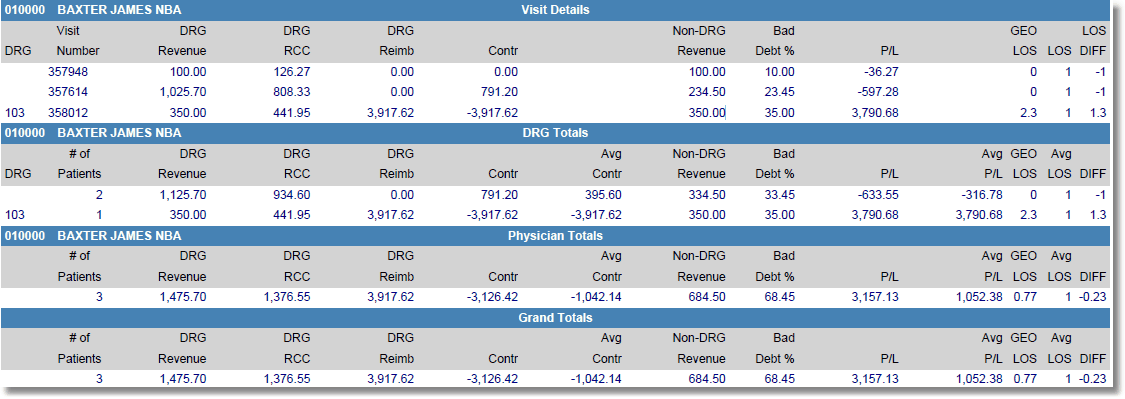|
<< Click to Display Table of Contents >> Description and Usage |
  
|
|
<< Click to Display Table of Contents >> Description and Usage |
  
|
This report provides a listing of all physicians reimbursed for each DRG and gives a cost analysis by Physician. There will be a Visit Details, DRG Totals and Physician Totals section for each physician and a Grand Totals section at the end of the report. The Visit Details section displays the DRG, visit number, DRG revenue (total charges), ratio of cost-to-charges, DRG reimbursement, contractual amount, non-DRG revenue (patient portion), bad debt percentage, profit and loss, geometric length of stay, length of stay and the length of stay difference. The DRG, Physician and Grand Totals sections display the DRG, the number of patients, DRG revenue (total charges), ratio of cost-to-charges, DRG reimbursement, contractual amount, average contractual, non-DRG revenue (patient portion), bad debt percentage, profit and loss, average profit and loss, the geometric length of stay, length of stay and the length of stay difference.
This report is an effective tool for analyzing the performance of physicians in relation to DRG costs and lengths of stay on individual DRGs. Administrators can evaluate the DRG revenue, cost, reimbursement and contractual cost for each physician to determine areas of profitability. This report also allows managers to analyze the profit or loss on a specific DRG considering a certain percentage of un-collectable debt.
Cost Analysis By Physician

Listed below is an explanation of each column.
Visit Details
•DRG: Pulls from the Grouper.
•Visit Number: The total number of patients for the listed physician and DRG.
•DRG Rev (DRG Revenue): Pulls charges from the patient’s Account Detail except for any charges that have “Include in DRG Rep” set to “N” in the Summary Charge Code Table.
•DRG RCC (Ratio of Cost to Charges): The amount in the DRG REV column is multiplied by the percent loaded in the DRG RCC field within the Summary Charge Code table to determine the Cost.
•DRG Reimb (DRG Reimbursement): The Medicare DRG Reimbursement loaded in the DRG table.
•Contr (Contractual): The DRG Reimbursement and patient portion is subtracted from the DRG Revenue to compute the Contractual.
•Non-DRG Revenue: The difference between the total charges and the expected pay amount that will be billed to the Insurance Company.
•Bad Debt % (Bad Debt Percentage): The bad debt percentage entered when printing the report. The bad debt percentage will be multiplied by the Patient Portion to obtain the Bad Debt Percentage amount.
•P&L (Profit and Loss): The DRG RCC and Bad Debt Percentage subtracted from the DRG Reimbursement and patient portion to compute the Profit and Loss.
•GEO LOS (Geometric Length of Stay): For the listed DRG.
•LOS (Length of Stay): The total number of patient days.
•DIFF (Difference): The Geometric Length of Stay minus the Length of Stay.
Totals
•DRG: Pulls from the Grouper.
•# of Pats (Number of Patients): The total number of patients for the listed physician and DRG.
•DRG Rev (DRG Revenue): Pulls charges from the patient’s Account Detail except for any charges that have “Include in DRG Rep” set to “N” in the Summary Charge Code Table.
•DRG RCC (Ratio of Cost to Charges): The amount in the DRG REV column multiplied by the percent loaded in the DRG RCC field within the Summary Charge Code table to determine the Cost.
•DRG Reimb (DRG Reimbursement): The Medicare DRG Reimbursement.
•Contr (Contractual): The DRG Reimbursement and patient portion subtracted from the DRG Revenue to compute the Contractual.
•Avg Contr (Average Contractual): The Contractual divided by the number of patients for the listed DRG computes the Average Contractual.
•Non-DRG Revenue: The difference between the total charges and the expected pay amount that will be billed to the Insurance Company.
•Bad Debt % (Bad Debt Percentage): The bad debt percentage entered when printing the report. The bad debt percentage will be multiplied by the Patient Portion to obtain the Bad Debt Percentage amount.
•P&L (Profit and Loss): The DRG RCC and Bad Debt Percentage subtracted from the DRG Reimbursement and patient portion to compute the Profit and Loss.
•Avg P&L (Average Profit and Loss): The Profit and Loss divided by the number of patients for the listed DRG computes the Average P&L.
•GEO LOS (Geometric Length of Stay): For the listed DRG.
•Avg LOS (Average Length of Stay): The total number of patient days divided by the total number of patients.
•DIFF (Difference): The Geometric Length of Stay minus the Average Length of Stay.